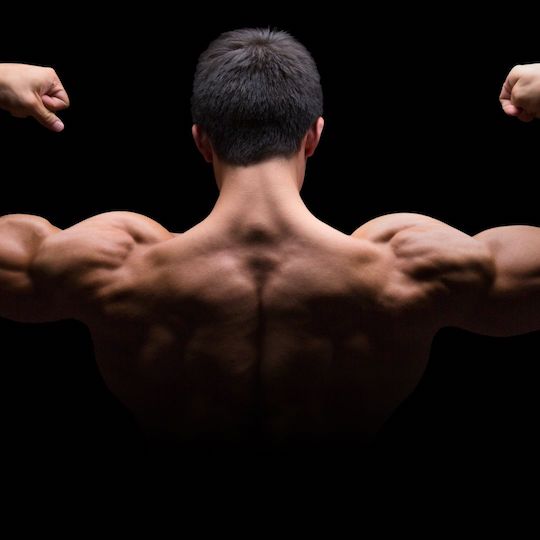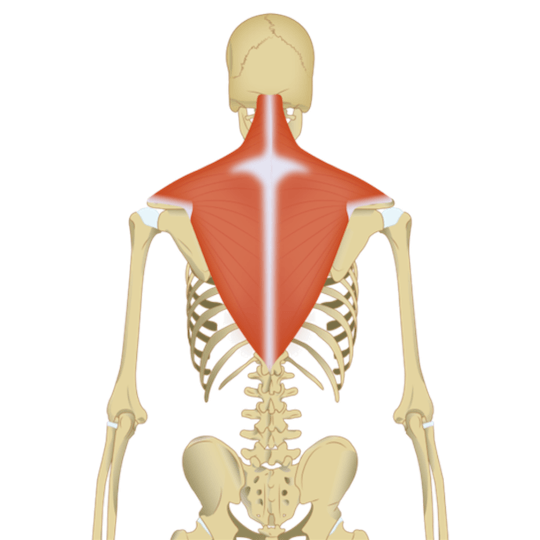For most people, a shrug of the shoulders is nothing more than a lazy way of saying "Don't ask me" or "I've got no idea". However, for those in the know, shoulder shrugs can be a great exercise to develop strength in the trapezius muscles of the upper back.
More...
What are shoulder shrugs?
The shoulder shrug is an exercise for the upper back. We perform it in a standing position, arms by the sides, holding a barbell (or a pair of dumbbells). A simple shrugging motion of the shoulders lifts the shoulder girdle.
Although the arms rise up with a shrug, they are not directly involved in the movement. Instead, they merely act as a means of applying extra resistance during the movement via the weight held in each hand.
Why perform shoulder shrugs?
There are two main reasons. When you perform shrugs, you work and strengthen the trapezius muscle of the upper back.
The trapezius muscles not only assist in the stabilisation of the shoulder, but they also act as secondary movers, particularly in overhead lifting movements. This extra strength and stability can help reduce the incidence of neck and shoulder injuries.

Another reason to perform shoulder shrugs is simple aesthetics. Strong trapezius muscles lend an inverted V-shape to the shoulder girdle and are indicative of upper body strength and power.
READ ALSO: Balance your body – what Da Vinci taught us
How do I perform shoulder shrugs?
In general, the most common form of the shoulder shrug exercise uses a barbell.
Start Position for Barbell Shoulder Shrug
- 1Place a barbell on the rack, about waist height.
- 2Walk up to the barbell and grasp it with your palms facing toward your body. Your hands should be around shoulder-width apart. That is, just outside your hips.
- 3Now take a step backwards from the rack and hold the bar with your arms down by your side.
- 4Next, stand upright with your feet hip-width apart. Ensure your tummy is tucked in, your torso and head are upright and looking directly forwards.
Technique for Performing the Barbell Shoulder Shrug Exercise
Step 1
Keeping the arms straight, without 'locking out' the elbows, and your torso stationary, shrug your shoulders smoothly but directly upwards as high as you can towards your ears.
Step 2
Don't be tempted to try to lift the barbell higher at the top of the movement by bending your arms at the elbows.
Step 3
When you can shrug no higher, pause briefly in that position.
Step 4
Now lower slowly, vertically downwards, and back to the start position. Lower until you feel a stretch in your trapezius muscles, but keep your elbows unlocked.
Step 5
Repeat.
Throughout the movement, remember to:
An alternative option for barbell shoulder shrugs - dumbbell shoulder shrugs
Although the barbell shrug is the most commonly performed shrug exercise, you can perform this exercise with dumbbells.
In fact, some people prefer to use dumbbells, because they allow a wider variety of hand positions. Therefore, reducing the stress on the wrist and allowing the arms to hang directly by the sides of the body.
Dumbbell shoulder shrugs exercise technique
The technique for dumbbell shrugs is essentially the same as for barbell shrugs. However, in the start position, the arms can hang further back. That is, in the same plane as your torso.
The orientation of the palms of the hands is also more flexible. Most people like to assume a 'palms facing the side of the thigh position' (i.e. with dumbbells aligned along a forwards/backward axis).
Safety and shoulder shrugs
In general, shoulder shrugs are a fairly safe exercise. However, if you are suffering from, or have a history of neck or shoulder girdle injuries, you should check with your physiotherapist before performing shrugs.
If you don't have access to a proper barbell rack and have to pick the barbell up from the floor, you should take care too when getting into the start position. Make sure you use correct lifting technique at all times. If you are unsure, ask your gym instructor or personal trainer to demonstrate this to you.
Those with a history of lower back problems may prefer dumbbell shrugs. In effect, they allow the torso to assume a slightly more upright stance than the 'bar in front' position of barbell shrugs. This, in turn, reduces the effort required by the lower back muscles to maintain a straight back.
READ ALSO: 10 Interesting Facts About Shoulder Pain
Which muscles are used in shoulder shrugs?
Performed correctly, shrugs are a pure isolation exercise, which means they target a single muscle group. In this case the trapezius muscles of the upper back.

However, it is possible to shift the emphasis slightly by changing the orientation of the torso. Leaning forward slightly while shrugging vertically upwards places more emphasis on the lower and middle portions of the trapezius. You can use an incline bench to support your upper body.
How should I construct a shoulder shrugs gym routine?
Like any isolation movement, quality is the key. Two sets of 12-15 reps using modest weight and strict form is far better than piling on the weight and throwing the body around. Ideally, we want to work the trapezius muscle with as much intensity as possible, but without recruiting many other supporting muscles.
How should I integrate shoulder shrugs into the rest of my gym workout?
The trapezius muscles are needed to assist the shoulders, especially on overhead pressing movements. As a result, it's best to perform shrugs only after your other shoulder work. Otherwise you'll struggle to properly work the shoulders.
Additionally, shoulder shrugs, especially with a heavy barbell, demand quite a bit of grip from the hand & forearm muscles. Therefore, you should also try to avoid doing them immediately before lat pulldowns and rowing-type exercises.
Do shoulder shrugs help posture?
Like most exercises, if we perform too many shoulder shrugs we can cause muscle imbalances. As a result, these muscle imbalances can lead to worse posture.

However, we can use a variation of the shoulder shrug to improve our upper body posture. In fact, I often recommend the forward lean shoulder shrug with clients displaying the following:
By using leaning shoulder shrugs, we can strengthen the lower and middle portions of the trapezius. As a result, we can counteract the effects of tight chest muscles. Subsequently, my clients often see an improvement in upper body posture and a reduction in neck and upper back pain.

